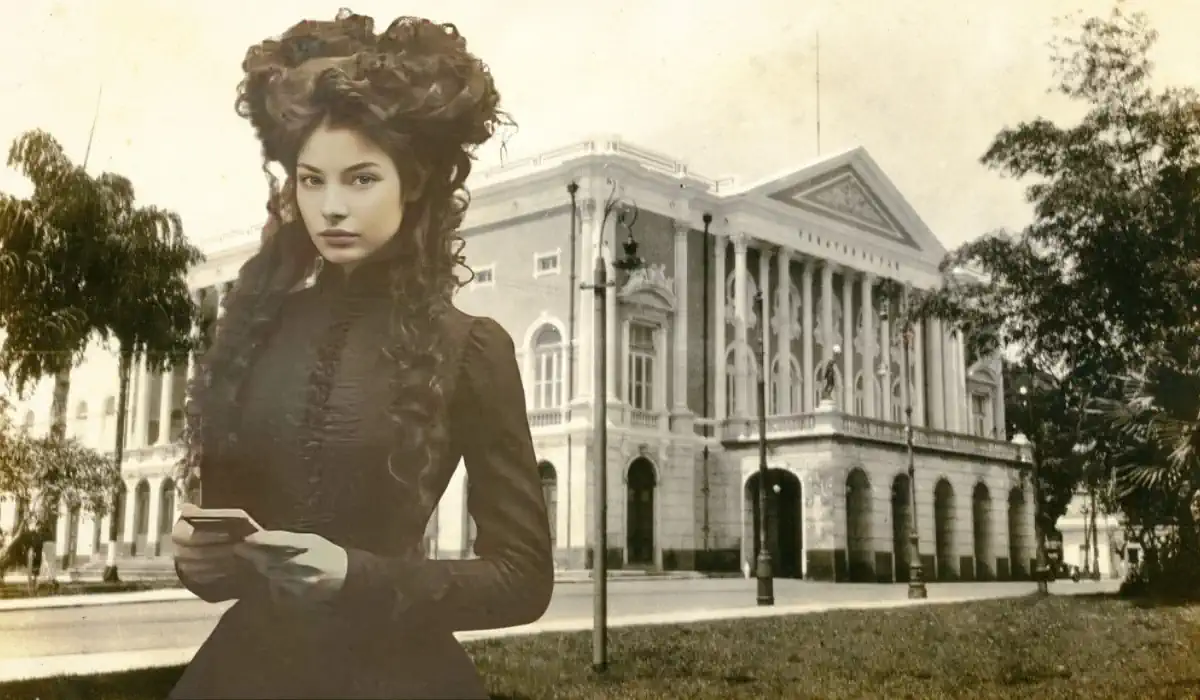In the annals of history, few figures have captured the imagination quite like Camille Monfort, the French opera singer whose life and legend continue to intrigue and mystify audiences over a century after her death.
Known as “The Amazonian Vampire,” Monfort’s story is a captivating blend of historical fact and mythical embellishment, set against the backdrop of the Amazonian rubber boom in late 19th century Brazil.
Early Life and Background
Camille Monfort was born in 1869 in France, entering the world with a silver spoon in her mouth. Her father, Henri Monfort, held the esteemed position of French diplomat and served as the consulate-general of France in Belém, the capital of the state of Pará in Brazil. Her mother, Marie Monfort, hailed from French aristocracy, boasting a familial connection to the Royal family of Orleans. This privileged lineage afforded Camille a life of luxury and opportunity from her earliest days.
In 1876, when Camille was just seven years old, the Monfort family relocated to Brazil, a move that would profoundly shape her future. This transition placed young Camille at the epicenter of a cultural melting pot, exposing her to a rich tapestry of French and Brazilian influences during her formative years.
The timing of their arrival coincided with the Amazonian rubber boom, a period of unprecedented economic growth that transformed Belém into a thriving hub of commerce and culture.
While specific details about Camille’s formal education remain scarce, it is reasonable to infer that her upbringing in a diplomatic and aristocratic family provided her with a comprehensive and refined education.
As was customary for young women of her social standing during that era, Camille likely received instruction from a governess, ensuring a well-rounded education that encompassed both French and Brazilian history and culture. This educational foundation, combined with her multicultural upbringing, undoubtedly contributed to her later success and the air of sophistication that surrounded her.
A Rising Star in Opera
As Camille blossomed into adulthood, her innate musical talent began to shine through. She developed a particular affinity for opera, a passion that would soon become the cornerstone of her career and the source of her fame. Camille’s voice was described as nothing short of hypnotic, possessing a quality that could captivate audiences and evoke powerful emotions.
Her performances at the prestigious Theatro da Paz in Belém quickly became the talk of the town. The theater, a symbol of the city’s newfound wealth and cultural aspirations, provided the perfect stage for Camille to showcase her extraordinary vocal abilities. Night after night, she would draw massive audiences, her voice filling the ornate hall and leaving spectators spellbound.
Camille’s appeal extended far beyond her vocal prowess. Standing at 5 feet 5 inches tall, she was renowned for her striking beauty and independent spirit. Her pale complexion, which would later fuel rumors of her supernatural nature, set her apart in the tropical climate of Belém. This unique appearance, combined with her mesmerizing performances, elevated Camille to the status of a true cultural icon.
The Birth of a Legend
It was during the height of her operatic career that the legend of “The Amazonian Vampire” began to take shape. Camille’s pale features and nocturnal lifestyle gave rise to whispers and speculation among the local population.
Some claimed that she had been afflicted with vampirism during a visit to London, using this fantastical explanation to account for her sickly appearance and the fainting spells that were said to occur during her concerts.
These rumors were further fueled by Camille’s unconventional behavior. She was often seen taking solitary walks under the moonlight, dressed in flowing black gowns that seemed to billow behind her like wings. This ethereal image, set against the backdrop of Belém’s gas-lit streets, only served to enhance her mysterious aura and feed the growing mythology surrounding her.
Challenging Societal Norms
Camille Monfort was more than just a talented singer or a subject of supernatural speculation. She was a woman who dared to defy the rigid social norms of her time, a trait that both fascinated and scandalized the conservative society of 19th century Belém.
Despite her beauty and the constant attention she received from suitors, Camille never married, a decision that was highly unusual for a woman of her social standing in that era. Instead, she engaged in a series of affairs with elite men, including a rumored relationship with Francisco Bolonha, a wealthy local figure. These romantic entanglements, conducted openly and unapologetically, challenged the prevailing notions of female propriety and independence.
Camille’s defiance of societal expectations extended beyond her romantic life. She was known to engage in activities that were considered unladylike at the time, such as smoking, horse riding, and even driving a motor car. Perhaps most scandalously, there were reports of Camille dancing half-naked in the streets of Belém during rainstorms, an act that both titillated and outraged the local populace.
The Spiritual Dimension
Adding another layer of intrigue to Camille’s already complex persona were the rumors of her involvement in spiritualism and the occult. It was said that she possessed abilities as a medium, capable of communicating with the dead and materializing spirits during séances. These activities, reportedly conducted in secretive cults within the palaces of Belém, were among the first manifestations of spiritualism in the Amazon region.
While the veracity of these claims remains unverified, they contributed significantly to the mystique surrounding Camille. The idea of a beautiful, talented woman who could not only entrance audiences with her voice but also bridge the gap between the living and the dead was irresistible to the public imagination. These rumors of spiritual prowess, combined with her vampiric legend, created a potent mythology that would long outlive Camille herself.
A Life Cut Short
The life of Camille Monfort, as extraordinary as it was, came to an abrupt and tragic end in 1896. Official records state that she fell victim to a cholera outbreak that swept through Belém, claiming her life at the young age of 27. She was laid to rest in the Cemetery of Solitude in Belém, her tomb becoming a site of pilgrimage for those captivated by her legend.
However, even in death, Camille Monfort continued to be a source of mystery and speculation. Rumors persisted that her death was merely a cover-up for her vampirism, with some claiming that her tomb was empty and that she had fled to Europe to continue her immortal existence. These tales, while fanciful, speak to the powerful impact Camille had made on the collective imagination of Belém and beyond.
Legacy and Cultural Impact
The legacy of Camille Monfort extends far beyond her brief life and operatic career. Her story, a compelling mixture of documented history and legendary embellishments, has inspired countless works of art, literature, and film. Artists and writers have found in Camille a muse that embodies the allure of the mysterious, the defiance of societal norms, and the blurring of lines between reality and myth.
In the realm of opera and performance, Camille’s influence was profound. Her ability to evoke strong emotions in her audience, sometimes causing them to faint, speaks to the power of her voice and stage presence. She set a new standard for what it meant to be not just a singer, but a true performer who could captivate and transport an audience.
Camille’s impact on society was equally significant. In an era when women were expected to conform to strict social norms, she stood as a beacon of independence and self-expression. Her lifestyle choices, while controversial at the time, challenged prevailing gender roles and highlighted the possibilities of female autonomy. In this way, Camille Monfort can be seen as an early, if unintentional, pioneer of women’s liberation.
The folklore that grew around Camille also had a lasting impact on the cultural landscape of Belém and beyond. The tales of her vampirism and spiritual abilities became intertwined with local mythology, contributing to the rich tapestry of Amazonian folklore. These stories, passed down through generations, have helped to keep the memory of Camille Monfort alive long after her passing.
Conclusion
Camille Monfort remains an enigmatic figure in history, her life a testament to the power of talent, charisma, and the human tendency to mythologize the extraordinary. From her privileged beginnings in France to her rise as an operatic sensation in Brazil, and finally to her status as a legendary figure of folklore, Camille’s journey is one that continues to captivate and intrigue.
Her story is more than just a tale of a talented singer or a supernatural being. It is a narrative that touches on themes of cultural exchange, artistic expression, social rebellion, and the enduring power of myth. In Camille Monfort, we see reflected the complexities of her era – the clash between tradition and modernity, the allure of the mysterious, and the yearning for freedom from societal constraints.
As we look back on the life of “The Amazonian Vampire,” we are reminded of the impact one individual can have on the cultural imagination. Camille Monfort’s legacy serves as a fascinating case study in how history and legend intertwine, creating a narrative that transcends time and continues to resonate with audiences today.
Whether remembered as a gifted opera singer, a defiant spirit, or a mythical creature of the night, Camille Monfort’s story remains a captivating chapter in the annals of cultural history. Her life, shrouded in both fact and fiction, continues to inspire and intrigue, ensuring that the legend of “The Amazonian Vampire” will endure for generations to come.













